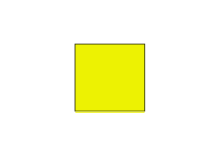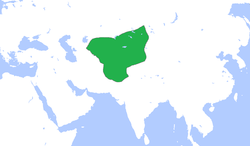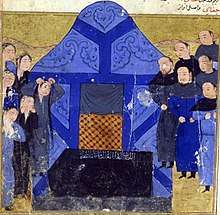Chagatai Khan
Chagatai Khan (Mongolian: Цагадай; Uyghur: چاغاتايخان , Tsagadai; Chinese: 察合台, Chágětái; Turkish: Çağatay; Persian: جغتای, Joghatai; 22 December 1183 – 1 July 1242) was the second son of Genghis Khan. He was Khan of the Chagatai Khanate in 1226–1242 C.E.[1] The Chagatai language and Chagatai Tajiks take their names from him. He inherited most of what are now five Central Asian states after the death of his father.[1] He was also appointed by Genghis Khan to oversee the execution of the Yassa, the written code of law created by Genghis Khan, though that lasted only until Genghis Khan was crowned Khan of the Mongol Empire.[1] The Empire later came to be known as the Chagatai Khanate, a descendant empire of the Mongol Empire. Chagatai Khan was considered hot-headed and somewhat temperamental by his relatives, because of his attitude of non-acceptance of Jochi as Great Khan.[1] He was the most vocal about this issue among his relations. Chagatai is in some stories held responsible for the death of Jochi and Genghis Khan.[1] At any rate, he was animated by the soldier-like spirit of his father and succeeded in keeping order among as heterogeneous a population as a kingdom was ever composed of.[1]
| Chagatai Khan | |
|---|---|
Statue of Chagatai Khan in Mongolia | |
| Khan of the Chagatai Khanate | |
| Reign | 1226 – 1241-42 |
| Predecessor | Genghis Khan |
| Successor | Qara Hülëgü |
| Born | 22 December 1183 |
| Died | 1 July 1242 (aged 58) Almaligh |
| Consort | Yesulun Khatun Togan Khatun Sevinch Khatun |
| Issue | Mutukan Baidar Yesü Möngke |
| Clan | Borjigin |
| Father | Genghis Khan |
| Mother | Börte Ujin |
| Religion | Tengriism |
Administration and religious tolerance


In 1232, when sedition showed itself at Bukhara, he acted with promptness, if with severity, and saved his country from a far-reaching calamity.[1] He was, in all probability, an old-fashioned Mongol, for he stood by the Yassa and that he showed little favor to what was, at that time in his dominions, the comparatively new and rising religion of Islam.[1] Muslims viewed Chagatai Khan with negativity and hostility because Chagatai Khan strictly enforced Mongol Yasa law against Islamic Shariah law banning Halal animal slaughter and Islamic prayer ritual ablution as well as the Islamic legal system. The Uyghur steward Vajir was accused of poisoning Chagatai Khan to death in 1242 by his wife Yisulun.[2][3] He was fairly tolerant, however, as his minister for Transoxiana was a Muslim, called the Jumilat-ul-Mulk or Qarachar Noyan,[4] and that mosques and colleges were founded during his reign.[1] Chagatai was also never inclined towards Christianity, though that religion, as practiced by the Nestorians, must have been familiar to him.[1]
Chagatai's own capital was at Almaligh, in the valley of the Upper Ili, near the site of the present Kulja, and consequently in the extreme east of his dominion.[1] His reason for fixing it in that remote position, instead of at Bukhara or Samarkand, was probably one of necessity. His Mongol tribesmen and followers—the mainstay of his power—were passionately fond of the life of the steppes.[1] The dwellers in houses and towns were, in their eyes, a degenerate and effeminate race: the tillers of the soil, slaves who toiled like cattle, in order that their betters might pass their time in luxury. They would serve no Khan who did not pass a life worthy of free-born men and Chagatai and his immediate successors probably saw, as his later descendants are described by Mirza Muhammad Haidar Dughlat to have seen that the one way of retaining the allegiance of his own people, was to humour their desires in this respect, and live, with them, a nomad's life.[1]
Family

Chagatai died in 1242, after a reign of about 16 years, and within the same year the death of Ogedai occurred at Karakorum.[1] Thus two out of four of the chief divisions of the Mongol empire were suddenly deprived of their sovereigns, with the result that nearly the whole of the successors of Genghis Khan began disputing for the succession.[1] However, for the time being, it ended in Turakina, Ogedai's widow, being appointed regent.[1] But lasting disputes remained among the rival claimants and for long afterward, the disputes regarding the succession to the throne of the great Khan became inextricably mixed up with the affairs, especially in the eastern part, of Chagatai's Khanate.[1]
Little is known of the way in which Chagatai disposed of his kingdom at his death, and there appears to be no mention, anywhere, of his having followed the ancestral custom of his house in distributing it among his descendants. He is recorded to have left a numerous family, but to have been succeeded by a grandson, and a minor, named Qara Hülëgü, while his widow, Ebuskun, assumed the regency.[1]
Mutukan
Chagatai's son Mutukan (Mö'etüken) was killed during the siege of Bamiyan in 1221.[5]
Turkistan, Transoxiana, and the adjacent regions were controlled directly by his descendants but not Kashghar, Yarkand, Khotan, Aksu, and the southern slopes of the Tian Shan mountains—or, in other words, to the province south of the line of the Tian Shan. As regards this province, Mirza Muhammad Haidar Dughlat says that it was given by Chagatai, presumably at his death, to the clan or house of Dughlat, whose members were reckoned to be of the purest Mongol descent, and one of the noblest divisions of that people.[1] The Dughlats were thus made hereditary chiefs, or Amirs, of the various districts of Eastern Turkestan, as far back as the time of Chagatai, for it is chiefly on this incident that hinges the permanent division of the Chagatai realm into two branches, at a later date.[1]
Baidar
Baidar was the sixth son of Chagatai Khan. He participated in the European campaign ("The elder boys campaign" as it was known in Mongolia) with his nephew Büri from 1235-1241. He commanded the Mongol army assigned to Poland with Kadan and, probably, Orda Khan.
Early in May 1241 they entered Moravia. Then they continued via Brno, to join Batu's main army in Hungary. The destruction in Poland, Silesia and Moravia was all much of the same kind.
In 1240 Baidar participated in the election of Güyük Khan in 1247.
Moucy
Moucy was the second son of Chagatai, son-in-law to Batu[6] (Batu Khan)
Moucy is mentioned by Giovanni da Pian del Carpine in his work History of Mongols whom we call Tatars (Ystoria Mongalorum).[7] In Carpine's work Moucy controlled territory on the left bank of the Dnieper in the land of Comans (Cumans) and he was senior to Korenca (Kuremsa) who was on the right bank.
Genealogy of Chagatai Khanate
In the Baburnama written by the founder of the Mughal Empire, Babur, Page 19, Chapter 1; described genealogy of his maternal grandfather Yunas Khan as:
Yunas Khan descended from Chaghatal Khan, the second son of Chlngiz Khan (as follows,) Yunas Khan, son of Wais Khan, son of Sher-'ali Aughldn, son of Muhammad Khan, son of Khizr Khwaja Khan, son of Tughluq-timur Khan, son of Aisan-bugha Khan, son of Dawa Khan, son of Baraq Khan, son of Yesuntawa Khan, son of Muatukan, son of Chaghatal Khan, son of Chingiz Khan.[8]
|
"Chughtai Khanates" A research project by Dr Abdul Rauf Mughal
Ancestry
| Hoelun | Yesugei Baghatur | ||||||||||||||||||||||||||||||||||||||||||||||||||||||
| Börte | Temüjin (Genghis Khan) | Hasar | Hachiun | Temüge | Belgutei | Behter | |||||||||||||||||||||||||||||||||||||||||||||||||
| Jochi | Chagatai | Ögedei | Tolui | ||||||||||||||||||||||||||||||||||||||||||||||||||||
| Preceded by Chagatai khanate established |
Khan of Chagatai Khanate 1225–1242 |
Succeeded by Qara Hülëgü |
References
- Mirza Muhammad Haidar Dughlat, N. Elias, Sir Edward Denison Ross (31 Dec 2008). A History of the Moghuls of Central Asia: The Tarikh-i-Rashidi. Cosimo, Inc. ISBN 9781605201504. Retrieved 2013-01-20.CS1 maint: multiple names: authors list (link)
- May, Timothy (2016). "Individuals Chagatai Khan (d. 1242)". In May, Timothy (ed.). The Mongol Empire: A Historical Encyclopedia [2 volumes]: A Historical Encyclopedia. Empires of the World (illustrated, annotated ed.). ABC-CLIO. p. 139. ISBN 161069340X.
- "CHAGHATAYID DYNASTY". ENCYCLOPÆDIA IRANICA FOUNDATION, INC. V (4): 343–346. December 15, 1991.
- William Erskine (1 Jan 1994). History of India under Baber. Atlantic Publishers & Dist. p. 577. ISBN 8171560326. Retrieved 2016-11-27.
- Ratchnevsky, Paul (1991) Genghis Khan: His Life and Legacy Blackwell, Oxford, UK, page 164, ISBN 0-631-18949-1
- Voitovycz, L. King of Poland Casimir III and a struggle for Romanovichi heritage (Польський король Казимир ІІІ і боротьба за спадщину Романовичів). "Lviv University Herald" (Вісник Львівського університету). Lviv 2011. page 8.
- da Pian del Carpine, G. History of Mongols whom we call Tatars (История Монголов, которых мы называем Татарами) Archived 2012-02-04 at the Wayback Machine. Translated by Aleksandr Malein. "State Publishing of Geographic Literature". 1957.
- The Babur Nama in English, Zahiru'd-din Mubammad Babur Padshah Ghdzt, ANNETTE SUSANNAH BEVERIDGE
![]()